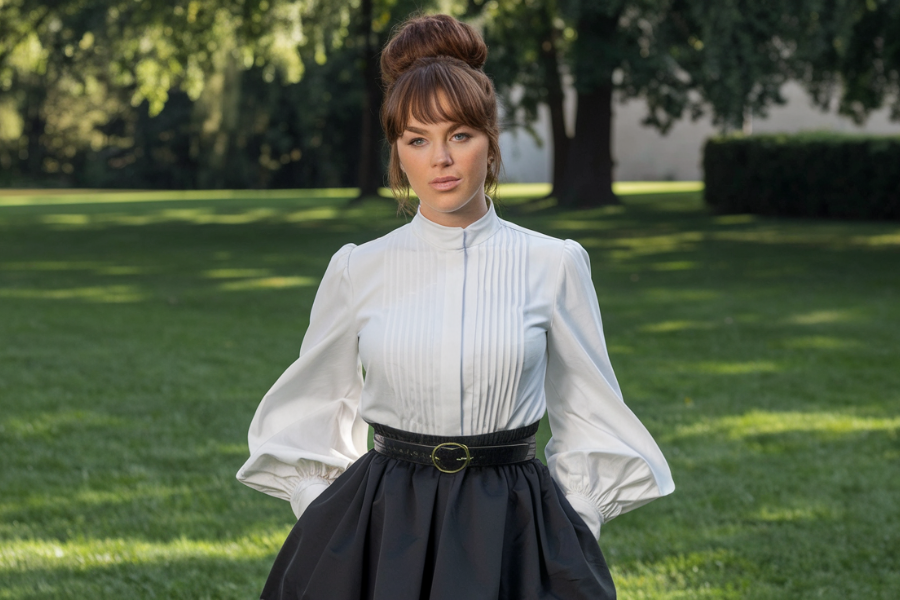Mary Musgrove is a character who has captivated audiences with her distinct charm, strength, and sense of fashion. For those with a passion for history, period dramas, or compelling character studies, her outfits offer an insightful glimpse into the fashion landscape of her era.
These wardrobe choices not only represent the fashion trends of the time but also provide deeper insights into her persona and character development.
In this exploration, we’ll examine the attire associated with Mary Musgrove, delving into its historical relevance, stylistic features, and how it helps bring this iconic character to life on screen.
Who Was Mary Musgrove?
Before delving into her attire, it’s crucial to understand the woman behind the style. Mary Musgrove was a historical figure known for her pivotal role in early American history. A Native American woman married to an Englishman, she played an essential role as a cultural and political mediator during the colonial era. Her life exemplified the intersection of two distinct worlds.
In terms of character portrayal, Mary is often depicted as resilient, independent, and resourceful. Her wardrobe in historical dramas reflects these qualities, often showcasing styles that blend elegance with practicality—a nod to her unique role in history.
The Role of Costume Design in Historical Dramas
In historical dramas, costume design goes beyond aesthetics; it’s a storytelling device. Through fashion, audiences gain insight into a character’s background, social standing, and personality. For Mary Musgrove, her outfits symbolize the convergence of two cultural identities—the British colonial settlers and Native American traditions. Her wardrobe choices mirror this duality, with European-inspired designs incorporating subtle yet significant nods to her Native American roots.
European Influences: Graceful Yet Functional Attire
Mary Musgrove’s clothing frequently incorporates elements of traditional British fashion, especially styles that were popular in the 18th century. Women’s fashion from this period often included ornate gowns, corsets, and full skirts made from luxurious materials such as silk and satin. However, Mary’s style differs from the excess seen in upper-class British fashion.
Depictions of Mary often show her wearing elegant but understated dresses crafted from lighter, more breathable fabrics. This choice reflects her active lifestyle and need for practicality. These garments, often featuring soft hues such as pale blue, ivory, or muted pastels, balance style with functionality. Her attire’s simplicity reflects her pragmatic approach to life and work, especially as a mediator dealing with settlers and indigenous communities.
The minimalistic nature of her outfits signals that status and luxury are secondary to comfort and utility. This practical approach is reflected in scenes where she is seen engaging in diplomatic discussions or handling essential business tasks, emphasizing her self-sufficiency and strategic role.
Cultural Significance: Nods to Native American Heritage
What sets Mary Musgrove apart from many of her contemporaries is her Native American heritage, which is subtly echoed in her fashion choices. In some portrayals, she is seen wearing accessories like beaded necklaces, handcrafted leather items, or woven textiles—all symbols of her cultural lineage.
These additions may be subtle, but they serve as visual reminders of her cultural roots. By blending Native American-inspired elements with European styles, Mary’s wardrobe communicates her ability to move fluidly between these two worlds. Her fusion of styles symbolizes her role as a cultural bridge, uniting elements of both Native and European identities into a cohesive whole.
The materials and design details of her attire often have symbolic significance. For instance, textiles may be inspired by Native American patterns, while still maintaining the structural form of British dresses. This blending of styles emphasizes her hybrid identity, underscoring her position as both a mediator and a woman of power.
Functionality as a Key Element in Mary Musgrove’s Wardrobe
A defining feature of Mary Musgrove’s wardrobe is its practicality. Her outfits are designed to suit an active lifestyle, one that requires her to meet British officials, negotiate with Native American leaders, and oversee daily affairs. Unlike the restrictive, multi-layered attire of aristocratic women, Mary’s clothing provides her with freedom of movement.
Her dresses typically feature loose-fitting bodices, flowing sleeves, and waistlines that allow flexibility. These garments are far more functional than the tight corsets and elaborate gowns worn by upper-class women of the period. Her footwear also reflects this practicality, as she is often depicted wearing simpler, more durable shoes—a detail that reinforces her active role as a negotiator and businesswoman.
This design approach highlights her status as more than just a passive historical figure. Her attire visually represents her strength, independence, and active engagement with both British settlers and Native American communities. Her clothing choices reflect a life of purpose and productivity.
Color Choice and Symbolism in Her Outfits
Color is a subtle yet powerful tool in historical dramas, and Mary Musgrove’s attire is no exception. Her wardrobe frequently features earthy tones, soft pastels, and tranquil shades of blue. Earthy colors like browns, beiges, and muted greens evoke a sense of groundedness, stability, and connection to nature—all traits associated with her Native American heritage.
Shades of blue, often linked to trust and loyalty, reinforce her role as a mediator and a figure of reliability. The use of light pastels, on the other hand, symbolizes calmness and subtle elegance. Unlike the bold, jewel-toned gowns worn by British aristocrats, Mary’s wardrobe projects a quieter authority, reflecting her role as a bridge between worlds.
When bolder colors are used, they typically coincide with moments of significance, like negotiations or pivotal conversations. While her wardrobe is never flamboyant, the selective use of color helps communicate her emotional state and character arc.
The Influence of Mary Musgrove’s Style on Popular Culture
Costume design in historical dramas can leave a lasting impression on audiences. Iconic looks worn by characters like Marie Antoinette or Elizabeth Bennet remain firmly etched in popular culture. Similarly, Mary Musgrove’s outfits have begun to take on a symbolic quality of their own.
Fans of historical dramas often discuss Mary Musgrove’s fashion sense, noting how her clothing choices encapsulate the balance between British colonial fashion and Native American heritage. Her unique blend of styles creates a visual reminder of her historical significance and complex identity.
As her story continues to be portrayed in film and television, her wardrobe may evolve to reflect modern interpretations of her character. Nevertheless, the core elements of her style—practicality, cultural symbolism, and understated elegance—are unlikely to change. These aspects of her wardrobe have become essential to her depiction in popular media.
Key Facts about Mary Musgrove’s Outfits
- Cultural Fusion: Mary Musgrove’s outfits blend elements of British colonial fashion with influences from Native American heritage, reflecting her unique role as a bridge between two cultures.
- Historical Context: Her clothing reflects the 18th-century British fashion norms, which featured gowns, corsets, and layered skirts. However, her attire was more practical and modest, aligning with her active lifestyle as a mediator.
- Practical Design: Unlike the elaborate gowns worn by aristocrats, Mary’s wardrobe focused on simplicity and comfort. Her garments often featured breathable fabrics and designs that allowed greater movement and flexibility.
- Use of Symbolic Accessories: Accessories such as beaded necklaces, woven sashes, and leather details are symbolic nods to her Native American roots, highlighting her dual cultural identity.
- Color Palette: Her outfits often incorporated earthy tones, soft pastels, and muted blues. Each color choice carried symbolic meaning — earthy tones representing nature and groundedness, while blues signified trust, loyalty, and calmness.
- Functional Footwear: Her footwear was practical and durable, contrasting with the decorative shoes of aristocratic women. This further reinforced her role as an
Conclusion:
Mary Musgrove’s attire exemplifies how clothing can transcend mere appearance and become a vital component of storytelling. Her fashion choices reveal her dual identity as both British and Native American, highlighting the complexities of her role as a mediator and leader.
Her practical, functional wardrobe aligns with her personality traits of independence and resilience. Her ability to merge elements of two distinct cultures in her clothing speaks to her broader role as a cultural bridge. These design choices create a visual narrative that enhances her legacy as a figure of strength, adaptability, and purpose.
Through her wardrobe, Mary Musgrove’s character continues to resonate with audiences. Her fashion remains a testament to the power of clothing as a storytelling tool—conveying identity, cultural fusion, and empowerment. Each choice of fabric, color, and style serves as a subtle yet powerful reflection of the story she represents.
Frequently Asked Questions (FAQs)
1. Who was Mary Musgrove, and why are her outfits significant?
Mary Musgrove was a prominent figure in early American history known for her role as a mediator between British colonists and Native American communities. Her outfits symbolize her unique identity, blending European colonial fashion with elements of her Native American heritage. Her attire reflects her role as a cultural bridge between two worlds.
2. What makes Mary Musgrove’s outfits unique compared to other historical figures?
Unlike other historical figures who adhered strictly to British or European fashion, Mary Musgrove’s outfits reflect a fusion of British colonial styles and Native American influences. Her wardrobe often incorporates symbolic accessories like beaded jewelry, leather items, and woven textiles, which highlight her cultural heritage.
3. What style elements define Mary Musgrove’s outfits?
Mary Musgrove’s clothing is characterized by simple yet elegant dresses inspired by 18th-century British fashion. These include modest gowns with breathable fabrics, flowing sleeves, and relaxed waistlines. Her outfits often have earthy color palettes, including browns, soft blues, and pastels, symbolizing calmness, loyalty, and a connection to nature.
4. How do Mary Musgrove’s outfits reflect her role in history?
Her outfits visually represent her role as a mediator between British settlers and Native American communities. The blending of British styles with Native American-inspired accessories symbolizes her ability to bridge two distinct cultures. Her practical and functional clothing also reflects her active role in diplomacy and negotiation.
5. What cultural influences can be seen in Mary Musgrove’s outfits?
Mary Musgrove’s wardrobe reflects both British and Native American influences. British fashion elements include gowns, skirts, and fabrics inspired by 18th-century European trends. Native American influences are seen in accessories like beaded necklaces, woven belts, and leather details, which symbolize her cultural heritage and connection to her indigenous roots.
6. Why is the color palette of Mary Musgrove’s outfits important?
The color palette of Mary Musgrove’s outfits often features earthy tones, soft pastels, and muted blues. These colors convey meaning: earthy tones symbolize stability and connection to nature, while blue is linked to trust and loyalty—qualities essential to her role as a mediator. Lighter colors and pastels represent her calm, composed, and thoughtful demeanor.
7. What materials were used in Mary Musgrove’s outfits?
Her outfits likely featured natural, breathable materials like linen, cotton, and wool, which were common in British colonial fashion. Leather and woven fabrics may have been used in Native American-inspired accessories, such as belts or decorative items, symbolizing her indigenous heritage.
8. How do Mary Musgrove’s outfits portray her personality and character?
Her practical and functional clothing choices reflect her independence, strength, and adaptability. Her understated style highlights her role as a negotiator, where appearance had to convey both professionalism and humility. The subtle incorporation of Native American elements into her outfits also emphasizes her pride in her cultural heritage.
9. How are Mary Musgrove’s outfits depicted in modern media and historical dramas?
In historical dramas, Mary Musgrove’s wardrobe is often depicted with simple gowns inspired by 18th-century British fashion, combined with Native American-inspired details such as beaded necklaces, woven accessories, and symbolic colors. Costume designers use these visual cues to emphasize her dual identity and her role as a cultural mediator.
10. What can we learn from Mary Musgrove’s outfits today?
Mary Musgrove’s outfits highlight the power of fashion as a tool for storytelling and cultural expression. Her clothing choices embody themes of identity, duality, and diplomacy. Today, her outfits remind us of the importance of embracing diverse cultural influences and using fashion to reflect personal identity and history.
Stay in touch to get more updates & alerts on Live Hint! Thank you



